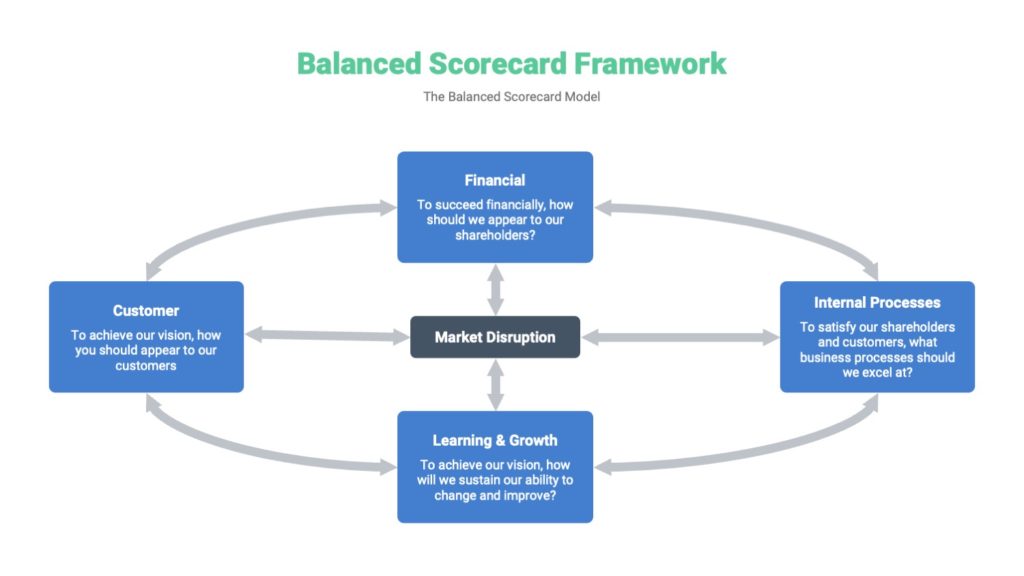The Balanced Scorecard is paramount as it provides a balanced view of the organisation, ensuring that strategic decisions are made considering financial, customer, process, and learning and growth perspectives.
The balanced scorecard allows companies to assess their performance holistically by combining financial and non-financial metrics. It provides a balanced perspective of four key areas: financial, customer, internal processes, and learning and growth. This integrated approach facilitates informed decision-making, enables performance measurement, and helps organisations translate their objectives into actionable steps.
Through a deep dive into the core components of the balanced scoreard, we will uncover the steps to implement it effectively. From defining a performance indicator (KPIs) to aligning metrics with strategic goals, we will guide you on a journey to maximise efficiency and drive growth.
Unlock the balanced scorecard’s power and unlock your business’s potential. Let’s get started.
The Four Perspectives of the Balanced Scorecard
The balanced scorecard bsc approach provides a balanced perspective of four key areas: financial, customer, internal processes, and learning and growth. Each perspective offers valuable insights into different aspects of the business and allows organisations to measure their performance holistically.

The balanced scorecard bsc approach provides a balanced perspective of four key areas: financial, customer, internal processes, and learning and growth. Each perspective offers valuable insights into different aspects of the business and allows organisations to measure their performance holistically.
Financial Perspective
The financial perspective focuses on financial measures such as revenue, profitability, and return on investment. It helps organisations evaluate their financial health and assess the effectiveness of their strategies in generating profits. By tracking financial metrics, businesses can identify areas for improvement and make data-driven decisions to drive growth.
Customer Perspective
The customer perspective looks at customer satisfaction, loyalty, and market share metrics. This perspective is crucial for understanding how well a company is meeting customer needs and expectations. By monitoring customer metrics, organisations can identify opportunities to enhance their products or services, build stronger customer relationships, and gain a competitive edge in the market.
Internal Business Processes
The internal business processes perspective examines the efficiency and effectiveness of the company’s internal operations. It focuses on metrics such as cycle time, quality, and productivity. Businesses can identify bottlenecks, streamline operations, and improve overall efficiency by analysing internal processes. This perspective is particularly important for organisations seeking to optimise their processes and reduce costs.
Learning and Growth Perspective
The learning and growth perspective examines employee development, innovation, and organisational culture metrics. It recognises that employees are the driving force behind organisational success and emphasises the importance of continuous learning and improvement. By investing in employee development and fostering a culture of innovation, organisations can cultivate the skills and capabilities necessary for long-term growth and adaptability.
The Harvard Business Review has a great article on the Balanced scorecard system in 1992. To learn more, check out this article written by the Harvard Business Review. It’s a great insight into how to align each key performance indicator, financial measures, strategic management, and operational. Measures and internal business process performance, a business can drive long-term success
Benefits of Using the Balanced Scorecard
The balanced scorecard approach offers several key benefits for businesses looking to maximise efficiency and drive growth. Firstly, it provides a comprehensive view of the organisation, allowing leaders to assess performance across multiple dimensions. This holistic view enables informed decision-making and ensures that actions align with strategic objectives.
Secondly, the balanced scorecard enables is focused on performance measures and the tracking of those performance measures. By defining key performance indicators (KPIs) for each perspective, organisations can monitor progress towards their goals and identify improvement areas. This data-driven approach facilitates continuous improvement and helps organisations stay on track to achieve their objectives.
Furthermore, the balanced scorecard helps organisations translate their objectives into actionable steps. Businesses can ensure everyone works towards a common purpose by aligning metrics with strategic planning and goals. This alignment fosters a sense of unity and direction within the organisation, increasing the likelihood of success.
Lastly, the balanced scorecard promotes accountability and transparency. By making performance metrics visible to employees, organisations create a culture of accountability where individuals take ownership of their responsibilities. This transparency also enables employees to understand how their work contributes to the organisation’s overall success, fostering a sense of purpose and motivation.
Implementing the Balanced Scorecard in Your Organisation
Implementing the balanced scorecard effectively requires a systematic approach and careful planning. Here are the key steps to follow:
1. Define Strategic Objectives: Start by defining your organisation’s strategic objectives. These objectives should be specific, measurable, achievable, relevant, and time-bound (SMART). They should align with your overall vision and mission.
2. Identify Key Performance Indicators: Once you have defined your strategic objectives, identify the key performance indicators (KPIs) that will measure progress. Be sure to select KPIs that are meaningful, actionable, and aligned with your strategic goals.
3. Align Metrics with Strategic Goals: Next, align the metrics associated with each perspective of the balanced scorecard with your strategic goals. Ensure that each metric reflects an aspect of your business that directly contributes to achieving your objectives.
4. Collect and Analyse Data: Collect the necessary data to measure each metric and regularly analyze the results. This data can come from various sources, such as financial reports, customer surveys, and employee performance evaluations. Use the data to identify trends, uncover insights, and make data-driven decisions.
5. Communicate and Cascade Objectives: Communicate the balanced scorecard objectives and metrics to all employees in your organisation. Ensure that each employee understands how their work contributes to the organisation’s overall success. Cascade the objectives down to each department or team, aligning individual goals with the organisation’s strategic goals.
6. Monitor and Adjust: Continuously monitor your organisation’s performance using the balanced scorecard. Regularly review the data, assess progress, and make adjustments as necessary. This iterative process ensures that your organisation stays on track and adapts to changing circumstances.
By following these steps, you can effectively implement the balanced scorecard in your organisation and unlock its full potential.
Key Performance Indicators (KPIs) for Each Perspective
To effectively measure performance across the four perspectives of the balanced scorecard, it is important to identify relevant key performance indicators (KPIs) for each perspective. Here are some examples of KPIs for each perspective:
Financial Measures:
– Revenue growth rate
– Return on investment (ROI)
– Gross profit margin
– Cash flow from operations
Customer Measures:
– Customer satisfaction score
– Net promoter score (NPS)
– Customer retention rate
– Market share
Internal Processes Measures:
– Cycle time
– Quality defect rate
– Employee productivity
– Process efficiency
Learning and Growth Measures:
– Employee satisfaction score
– Training hours per employee
– Employee turnover rate
– Number of new product ideas generated
These are just a few examples of the many KPIs that can be used to measure performance in each perspective. Your specific KPIs will depend on your industry, business model, and strategic objectives. It is crucial to select KPIs that are relevant, actionable, and aligned with your goals.
Aligning the Balanced Scorecard with Your Business Goals
To maximise the effectiveness of the balanced scorecard, it is important to align it with your business goals. Here are some tips to ensure alignment:
1. Start with the End in Mind: When developing your balanced scorecard, clearly define your business goals. Understand what you want to achieve and how the balanced scorecard can help you.
2. Cascade Objectives: Cascade your business goals to each department or team within your organisation. Ensure that each individual understands how their work contributes to achieving the overall goals.
3. Link Metrics to Objectives: Align the metrics associated with each perspective of the balanced scorecard with your business goals. Ensure that each metric reflects an aspect of your business that directly contributes to achieving your objectives.
4. Regularly Review and Adjust: Continuously review your organisation’s performance using the balanced scorecard. Regularly assess progress towards your goals and make adjustments as necessary. This iterative process ensures that your organisation stays focused and adapts to changing circumstances.
By aligning the balanced scorecard with your business goals, you can ensure that your efforts are directed towards what truly matters and maximise the impact of your strategies.
Hoshin Kanri vs. Balanced Scorecard: Understanding the Differences
While both Hoshin Kanri and the Balanced Scorecard are strategic planning tools used to align an organisation’s operations with its long-term goals, they differ in a few key aspects.
Hoshin Kanri, a Japanese methodology meaning ‘direction management’, focuses on strategic goal-setting to align every level of an organisation. The method uses a ‘catchball’ process, a back-and-forth dialogue between different managerial levels to ensure alignment and buy-in. It’s centred on a breakthrough objective that significantly impacts the company’s performance, with an emphasis on consensus-building and continuous improvement.
On the other hand, the Balanced Scorecard is a performance measurement framework that provides a balanced view of an organisation’s performance by considering financial and non-financial measures. It focuses on four key perspectives—financial, customer, internal processes, and learning and growth.
These perspectives help organisations monitor performance and identify areas for improvement.
In essence, while Hoshin Kanri is predominantly a goal-setting and alignment tool, the Balanced Scorecard is a performance measurement and management tool. Both methodologies are valuable in driving strategic success, but they serve slightly different purposes within an organisation.
Tools and Software for Managing the Balanced Scorecard
Managing the balanced scorecard effectively requires the right tools and software. Here are some popular options:
1. BSC Designer: BSC Designer is a cloud-based software that allows organisations to create, manage, and track their balanced scorecards. It offers a user-friendly interface, powerful analytics, and collaboration features.
2. QuickScore: QuickScore is a comprehensive, balanced scorecard software that enables organisations to align their objectives, measure performance, and track progress. It offers many features, including strategy mapping, scorecard design, and automated reporting.
3. KPI Fire: KPI Fire is a performance management software that helps organisations implement and manage their balanced scorecards. It offers goal-setting tools, real-time dashboards, and collaboration features to improve performance.
4. Microsoft Excel: While not explicitly designed for balanced scorecard management, Microsoft Excel can be a cost-effective solution for small to medium-sized businesses. With its robust data analysis and visualisation capabilities, Excel can be used to create and track balanced scorecards.
These are just a few examples of tools and software for managing the balanced scorecard. The specific tool you choose will depend on your organisation’s needs, budget, and technical requirements. It is important to select a tool that aligns with your goals and provides the necessary features to manage your balanced scorecard effectively.
Measuring and Tracking Performance Using the Balanced Scorecard
Measuring and tracking performance using the balanced scorecard is a continuous process that requires regular monitoring and assessment. Here are some tips to effectively measure and track performance:
1. Collect Relevant Data: Collect the necessary data to measure each metric in your balanced scorecard. Ensure that the data is accurate, reliable, and up-to-date. This may involve gathering data from various sources, such as financial reports, customer surveys, and employee feedback.
2. Establish Baselines: Establish baselines for each metric to provide a point of reference for future measurements. Baselines allow you to track progress and assess the effectiveness of your strategies. They also help identify trends and patterns over time.
3. Set Target Values: Set target values for each metric based on your business goals and industry benchmarks. Target values provide a clear objective to strive for and help motivate employees. They also serve as a guide for decision-making and resource allocation.
4. Regularly Review Metrics: Regularly review the metrics in your balanced scorecard to assess performance. Analyse the data, identify trends, and compare results against baselines and target values. This ongoing review process enables you to identify areas for improvement and make data-driven decisions.
5. Communicate Results: Communicate the results of your balanced scorecard measurements to all stakeholders within your organisation. Ensure that employees understand the significance of the metrics and how they contribute to the overall success of the organisation. This transparency promotes accountability and fosters a culture of continuous improvement.
By measuring and tracking performance using the balanced scorecard, organizations can identify areas for improvement, make informed decisions, and drive sustainable growth.
Conclusion and Next Steps for Implementing the Balanced Scorecard
Implementing the Balanced Scorecard in your organisation is a strategic move to enhance performance and align your team towards your long-term goals. However, the success of this initiative is not solely dependent on execution but requires a commitment to ongoing monitoring, analysis, and adjustments.
Start by ensuring that everyone in your organisation understands the Balanced Scorecard methodology and its significance. Conduct workshops or training sessions that outline its benefits and how it will be used to track performance. All team members must comprehend the metrics and targets on your scorecard.
Following the introduction and understanding stage, integrate the Balanced Scorecard into your existing systems and processes. This could involve aligning it with your existing performance appraisal systems or integrating it into your project management software.
Regular and consistent performance reviews are key to the success of the Balanced Scorecard. Ensure that you are tracking results and analysing them to identify trends and areas for improvement. Remember, the Balanced Scorecard is not a set-and-forget tool; it should evolve with your organisation and its goals.
Lastly, be prepared to adjust as necessary. If certain metrics are no longer relevant or if targets need to be revised, make those changes. The flexibility of the Balanced Scorecard is one of its most valuable characteristics.
As such, the balanced scorecard is not just a performance measurement tool; it’s a management system that enables organisations to clarify their vision and strategy, translate them into action, and provide a way for enterprises to track their performance against their strategic goals. The Balanced Scorecard can significantly improve your organisation’s performance with commitment and careful implementation.
At Leanscape, we understand the importance of strategic alignment and performance measurement in achieving business growth. That’s why we provide comprehensive consultancy services to businesses looking to implement the Balanced Scorecard (BSC) methodology. Our team of experts work closely with you to understand your unique needs and guide you throughout the BSC implementation process, ensuring your strategies are aligned with your long-term objectives. With Leanscape, you gain a trusted partner invested in your success.




